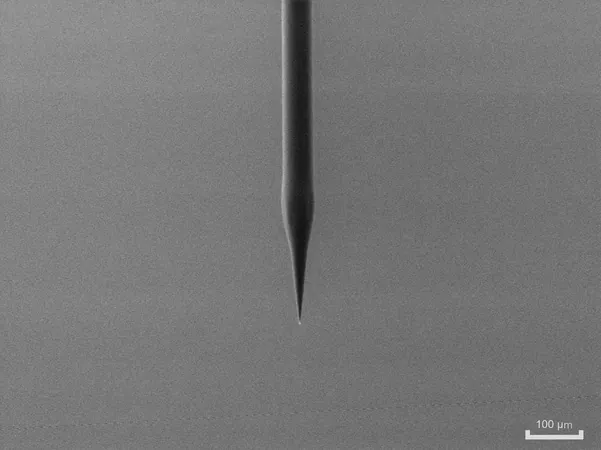
Revolutionizing Neuroscience: Tapered Polymer Fibers Set to Transform Light Delivery in Brain Research!
2025-01-15
Author: Nur
Revolutionizing Neuroscience: Tapered Polymer Fibers Set to Transform Light Delivery in Brain Research!
A groundbreaking advancement in neuroscience research has emerged as scientists unveil a new method for creating tapered polymer optical fibers that enhance the delivery of light to the brain. This innovative technology promises to revolutionize our understanding of various neurological conditions through more effective animal studies.
The tapered fibers, characterized by their conical shape, are specifically designed for neuroscience applications, including optogenetic experiments and fiber photometry. These methods utilize the interaction between genetically modified neurons and visible light, enabling researchers to explore brain functionality with unprecedented clarity.
Marcello Meneghetti, a key member of the research team from the Technical University of Denmark, explains the significance of this new design. “Our tapered fibers allow easier penetration into brain tissue and can illuminate larger areas, leading to a better understanding of complex neural circuits,” he stated. “Unlike conventional cylindrical fibers, which can miss out on illuminating vital neuronal networks, these tapered solutions can reach and affect more cells.”
A Game-Changer for Long-term Brain Studies
One of the most striking advantages of these tapered polymer fibers is their ability to cause significantly less tissue inflammation over extended implantation periods compared to traditional glass fibers. Meneghetti pointed out that using flexible polymers instead of rigid glass mitigates the common challenges of implant breakage and inflammation that arise due to the mechanical mismatch between the implant and brain tissue. The result? A more effective, long-term monitoring solution for neuroscientists.
Published in the journal Optics Letters, the researchers detail their innovative design process, which involved the creation of polymer fibers just 50 microns in diameter — roughly the thickness of a human hair! This microscale design allows for greater light modulation and the ability to record neuronal activity from more extensive brain networks.
Illuminating the Path to Understanding Complex Behaviors
The implications of this technology are immense. Meneghetti emphasized, “By illuminating more neurons, we can better understand how brain circuits operate and how various behaviors are regulated. It opens new doors for studying brain diseases and disorders, potentially leading to more effective treatments.”
Traditional cylindrical optical fibers are excellent at confining light; however, the conical shape of the new fibers enables light to spread out more effectively along the tapered tip. This unique property helps illuminate a much larger volume of brain tissue, crucial for comprehensive neuronal studies.
Optimizing the Future of Neurotechnology
The researchers employed advanced numerical models and chemical etching techniques to craft these tapered optical fibers. Following rigorous testing, they confirmed that the new fibers demonstrated more than double the lateral light spread compared to standard optical fibers, a significant breakthrough.
Looking ahead, the team intends to validate the performance of these tapered fibers in animal models to further assess their capability to minimize inflammation. The long-term vision includes integrating their fabrication techniques with advanced nanofabrication processes, potentially leading to sophisticated devices that can deliver light, capture electrical signals, and even sense temperature or chemical alterations within the brain.
The Untapped Potential of Tapered Fibers
The future of neuroscience research is bright, with these newly crafted tapered polymer fibers poised to unlock the secrets of the brain. As researchers continue to push the boundaries of neurotechnology, we can anticipate groundbreaking discoveries that may unravel the complexities of brain function in both healthy and diseased states.
Keep your eyes on this space — the next wave of neurodiscovery is just around the corner, and it could change the way we understand our minds!
 Brasil (PT)
Brasil (PT)
 Canada (EN)
Canada (EN)
 Chile (ES)
Chile (ES)
 Česko (CS)
Česko (CS)
 대한민국 (KO)
대한민국 (KO)
 España (ES)
España (ES)
 France (FR)
France (FR)
 Hong Kong (EN)
Hong Kong (EN)
 Italia (IT)
Italia (IT)
 日本 (JA)
日本 (JA)
 Magyarország (HU)
Magyarország (HU)
 Norge (NO)
Norge (NO)
 Polska (PL)
Polska (PL)
 Schweiz (DE)
Schweiz (DE)
 Singapore (EN)
Singapore (EN)
 Sverige (SV)
Sverige (SV)
 Suomi (FI)
Suomi (FI)
 Türkiye (TR)
Türkiye (TR)
 الإمارات العربية المتحدة (AR)
الإمارات العربية المتحدة (AR)